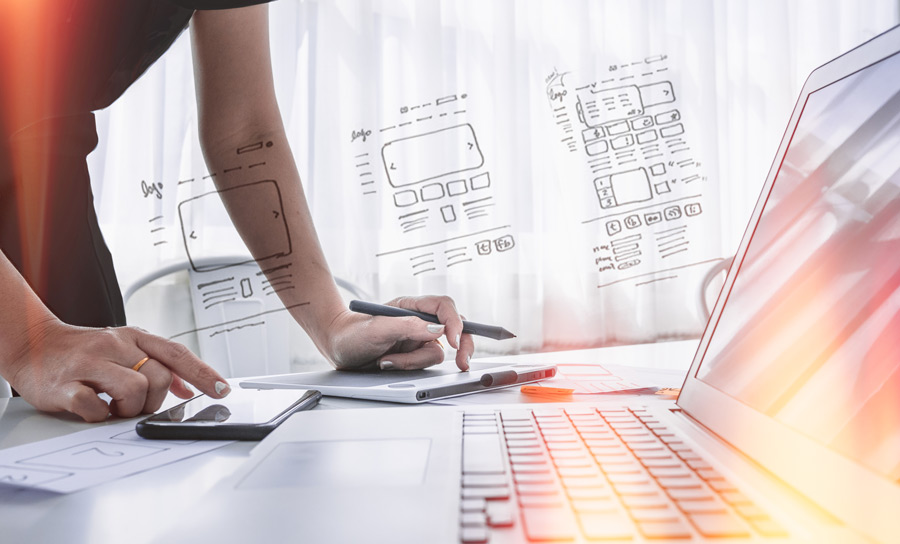ESYON has already implemented numerous e-commerce platforms for medium-sized businesses. In addition to automating and optimizing processes, the focus is always on an intuitive shopping experience. Contact us and benefit from over a decade of experience in e-commerce.

Usability and CX in the shop: How to improve your customer experience
Similarities and Differences
The term "usability" can best be translated as user-friendliness. The goal of every online shop, whether B2C or B2B, should be to quickly and intuitively lead the user to the content they are looking for. Usability is essentially a hygiene factor: when implemented well, users hardly notice it. However, poor usability is perceived as extremely annoying by visitors to a site. However, this does not mean that companies cannot benefit from considering the user-friendliness of their shop. A successful user guidance will lead potential customers to stay longer on your site and be more willing to buy your products. Customer Experience (CX) takes this approach even further, adding aesthetic and emotional factors to the intuitive operation. An appealing design and interaction with the content should invite visitors to linger and build trust in the company.
In the B2B sector, customer experience is often poor: Why is that?
A large proportion of B2B customers perceive the user experience as poor. Why is that? Reasons can be found primarily in the products themselves: Complex B2B products often require intensive consultation. However, the e-commerce platforms of companies still often lack appropriate solutions for digital communication. The websites mainly serve as digital product catalogs – orders are placed by phone, email, or fax. In our experience, B2B shops also rely too much on business relationships. Compared to the B2C sector, B2B e-commerce is characterized by a significantly smaller customer base. Instead, the same customers repeatedly place orders with the companies. Due to these constellations, merchants are rarely prompted to question the user experience. However, doing so could help attract new customers in a smaller market.
Improving CX: Benefits
According to mckinsey.com, the benefits of satisfactory usability and customer experience can be demonstrated with numbers. According to the renowned management consultancy, the following effects were observed in various companies after investing in CX:
10-15% lower bounce rates
20-40% higher conversion rates
Up to 50% cost savings in customer support
Measuring CX: This is how it's done
Many companies do not know whether their CX needs improvement or not. The reason for this is that usability and customer experience are very subjective perceptions. The perception of decision-makers can be clouded by everyday business life and daily interaction with the B2B shop. Therefore, it is important to first obtain independent feedback from customers, which can also be measured based on simple formulas.
Net Promoter Score
One of the classic measurement methods is the Net Promoter Score (NPS), which compares the promoters of the online shop with the detractors.
NPS = Promoters (%) - Detractors (%)
The NPS is based on a simple question: "Would you recommend our online shop?"
Ideally, you should offer your customers response options between 0 (extremely unlikely) and 10 (extremely likely). Those who give a 9 or 10 are considered promoters. Critics can be classified as all respondents between 0 and 6. People who answer with 7 and 8 are classified as passively satisfied users and are not taken into account for calculating the NPS.

Our Tip 7 cornerstones of successful Usability and CX
Here we present a range of points that will help you turn your B2B shop into an intuitive e-commerce platform that fosters customer engagement.
1. User-friendly design
A user-friendly design is not just about aesthetic aspects. Crucial for user guidance, whether B2B or B2C, is navigation. It should focus on user-relevant topics and help find them quickly. An intelligent search should follow, whose importance is sometimes underestimated. In addition to filter functions that significantly simplify product search, the search can also contribute to a personalized customer experience by sorting search results based on user behavior.
2. Process optimization with ERP and PIM
B2B customers often inquire about products needed for their own production and process chains. If delays occur in order processing due to manual and/or faulty processes, the business relationship can be significantly damaged. With the help of ERP systems (= Enterprise Resource Planning), companies automate their processes to minimize time and error sources. The ERP brings together all goods and data flows, giving you a better overview and control of your business processes. This contributes to increased efficiency of your company, which also has a positive impact on the external presentation. A renowned ERP is Microsoft Dynamics 365.
You can further optimize the management of your product data with PIM (= Product Information Management). Changes to the data are synchronized across all channels with a single maintenance effort. You can also manage your product information in multiple languages and use it to create a catalog if desired. This way, both your sales and your customers have all the information they need for purchase advice or decisions.
Read tip: With our Product Configurator, we provide you with a solution that allows you to offer configurable products in your shop.
1. Improving loading times
According to Google statistics, 53% of users leave a website if it takes more than 3 seconds to load. Especially on mobile devices, loading times are often longer, which is why your e-commerce platform needs a performant server architecture that quickly delivers content. In this context, cloud hosting has proven itself. Unlike on-premise solutions, where you only have your own server capacity available, here you can access an entire computer network. With Microsoft Azure, Microsoft operates one of the largest cloud networks worldwide, which is ideally suited for B2B e-commerce.
2. Different Sales Channels
Having various points of sale (PoS) reduces your dependence on a single sales channel and ensures the economic stability of your business. It is also important for the user experience. For example, many customers start their product search on Amazon out of habit and eventually make the purchase on the marketplace. Therefore, it makes sense to offer your products outside of your own online shop. One solution to connect your e-commerce platform to Amazon is the Amazon Marketplace Connector by ESYON.
3. Mobile Commerce
Online purchases via mobile devices are increasing every year, even in the B2B sector. Responsiveness is therefore one of the most important factors for a comfortable shopping experience. It is crucial that content is displayed correctly and is quickly accessible.
Mobile Apps
Especially in the B2B sector, where customers make repeated purchases, a mobile app can pay off in addition to responsive design. Therefore, let's take a closer look at the benefits of having a mobile app.
- Faster Access: With an app, customers can quickly access your products and services without having to visit a website or navigate in a browser. An app typically offers a more user-friendly and faster experience than a mobile website.
- Personalized Experience: An app can offer personalized features such as product recommendations, special offers, or personalized notifications. This makes customers feel more attached to the company and enhances their overall customer experience.
- Simplified Navigation: An app can provide simpler navigation than a website, which better adapts to the requirements of mobile devices. Additionally, an app can offer features such as saving search queries and orders to facilitate the purchasing process for customers.
- Push Notifications: An app allows companies to notify customers of special offers or news through push notifications. This helps keep customers informed and engaged with special promotions.
- Streamlined Ordering Process: With a mobile app, the ordering process can be significantly simplified. For example, your customers can use the barcode scanner on their smartphones to reorder a product and add it to the shopping cart.
1. Improving Customer Service
Customer service also contributes to the user experience. Companies that respond quickly to returns or inquiries and offer uncomplicated solutions are perceived more positively. This is almost even more important in the B2B sector than for companies in B2C e-commerce because of significantly closer customer relationships.
Usability and CX at ESYON
A successful user experience is one of the essential pillars of our work. We would like to share with you how we have implemented CX and usability in previous projects.
Lekkerland Österreich
ESYON developed an e-commerce solution for Lekkerland Österreich, combining PIM and a webshop. The platform provides more clarity for buyers and constantly updated information sourced from Product Information Management. Additionally, the complaint management was improved to further optimize customer service. More information can be found in our case study with Thomas Brandstetter.
Read Case Study
KUBO
The new e-commerce platform for Swiss company KUBO Tech AG combines personalized shopping experiences with time savings. The new webshop allows for customer-specific prices, discount promotions, and products. The platform is personalized through an intelligent search and filter. Furthermore, Microsoft Dynamics 365 ERP automates many standard processes. Learn more in our case study.
Read Case Study
Erfal
ESYON supported the launch of Erfal's first webshop back in 2016. The shop has since received a redesign, with a focus on responsiveness. As a manufacturer of insect and sun protection, Erfal rarely produces the same product twice. Instead, customers can configure and order their desired product directly on the webshop, utilizing our in-house Product Configurator feature. Further details can be found in our case study.
Read Case Study
array(8) {
["@type"]=>
string(11) "NewsArticle"
["identifier"]=>
string(17) "#/schema/news/150"
["headline"]=>
string(69) "Usability and CX in the shop: How to improve your customer experience"
["datePublished"]=>
string(25) "2023-07-18T12:08:00+02:00"
["url"]=>
string(74) "/news/usability-and-cx-in-the-shop-how-to-improve-your-customer-experience"
["description"]=>
string(570) "Customer experience is becoming increasingly important in online commerce. However, in B2B e-commerce, the fulfillment of customer requirements often lags behind the B2C sector. More and more B2B customers expect an individual and intuitive shopping experience similar to what they are accustomed to as private buyers. In this article, we will take a look at what the terms "usability" and "customer experience" exactly describe and why it is worth improving the user experience of your B2B shop. We will present effective measures that you can apply to your e-commerce."
["author"]=>
array(2) {
["@type"]=>
string(6) "Person"
["name"]=>
string(13) "Steffi Greuel"
}
["image"]=>
array(6) {
["@type"]=>
string(11) "ImageObject"
["caption"]=>
string(0) ""
["contentUrl"]=>
string(62) "/assets/images/2/shop-usability-cx-670x415-3k1zy9211sng202.jpg"
["identifier"]=>
string(51) "#/schema/image/4286803a-ef41-11ed-9dc1-03dc47cc2e7f"
["license"]=>
string(0) ""
["name"]=>
string(0) ""
}
}